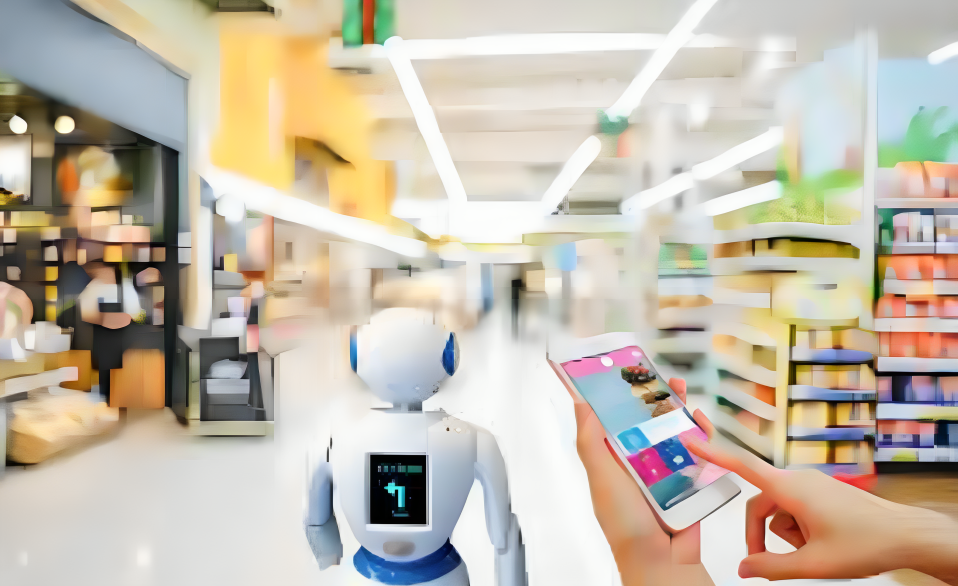
In the dynamic landscape of retail, a seismic shift is underway, and the grocery store experience stands at the epicentre of this revolution. The year 2024 heralds a new era shaped by the transformative influence of Artificial Intelligence (AI). Beyond mere technological advancement, AI emerges as a disruptive force, fundamentally reshaping how we shop.
Brace yourself for an exploration into the future, where every aisle holds the promise of unprecedented convenience, hyper-personalisation, and a shopping journey redefined by the ingenuity of AI.
1. Smart shelves and inventory management
AI is revolutionising inventory management through the implementation of smart shelves. These intelligent shelves utilise sensors and RFID technology to monitor stock levels in real time. This not only minimises instances of out-of-stock items but also optimises restocking processes, ensuring that shelves are consistently well-stocked. The result? A seamless shopping experience for customers with products readily available when needed.
2. Personalised shopping recommendations
AI algorithms have evolved to understand individual shopping preferences with remarkable accuracy. As customers navigate the aisles, AI-driven systems analyse past purchase history, preferences, and even real-time movements to offer highly personalised recommendations. Whether it’s dietary preferences, favourite brands, or special promotions, AI tailors the shopping journey to cater to the unique needs and desires of each customer.
3. Checkout-free shopping experiences
The checkout queue is becoming a relic of the past, thanks to AI-powered checkout-free experiences. Retailers are deploying computer vision and sensor fusion technologies to create frictionless shopping environments. Customers can simply pick up their desired items and walk out of the store, with AI automatically tracking and charging for the items through a seamless, contactless payment process.
4. Predictive pricing models
Dynamic pricing models are leaping forward with the integration of AI. Retailers are leveraging predictive analytics to adjust prices in real-time based on various factors such as demand, inventory levels, and even external factors like weather conditions. This ensures competitive pricing, maximises revenue, and provides customers with fair and transparent pricing.
5. Enhanced customer service through chatbots
AI-driven chatbots are becoming essential customer service companions in grocery stores. These intelligent bots assist customers with queries about product information, and store layout, and even offer recipe suggestions based on purchased items. By providing instant and helpful information, chatbots enhance the overall customer experience, creating a more engaging and informative shopping environment.
6. AI-enabled supply chain optimisation
Behind the scenes, AI is optimising the entire supply chain, from farm to store. Predictive analytics and machine learning algorithms forecast demand, helping suppliers and retailers manage inventory efficiently. AI’s ability to analyse vast datasets also aids in identifying potential disruptions, ensuring a steady and reliable supply of fresh produce and products.
7. Virtual shopping assistants
AI introduces virtual shopping assistants that guide customers through the store via augmented reality interfaces on their smartphones. These assistants offer real-time product information, promotions, and navigation guidance, creating an immersive and interactive shopping experience.
8. Sustainable shopping practices
AI contributes to sustainability by helping retailers optimise stocking patterns, reduce food waste, and implement eco-friendly practices. Algorithms analyse consumption patterns and expiration dates to minimise waste, promoting a more environmentally conscious approach to grocery retail.
9. Hyper-personalised loyalty programs
AI-driven loyalty programs go beyond generic discounts, offering hyper-personalised incentives based on individual shopping behaviours. This level of personalisation enhances customer loyalty by providing tailored rewards that align with each shopper’s preferences and purchasing history.






![Read more about the article [Funding alert] Deluxe Recycling raises funds from Circulate Capital](https://blog.digitalsevaa.com/wp-content/uploads/2022/04/DeluxeSorting-1649141542348-300x200.jpg)



